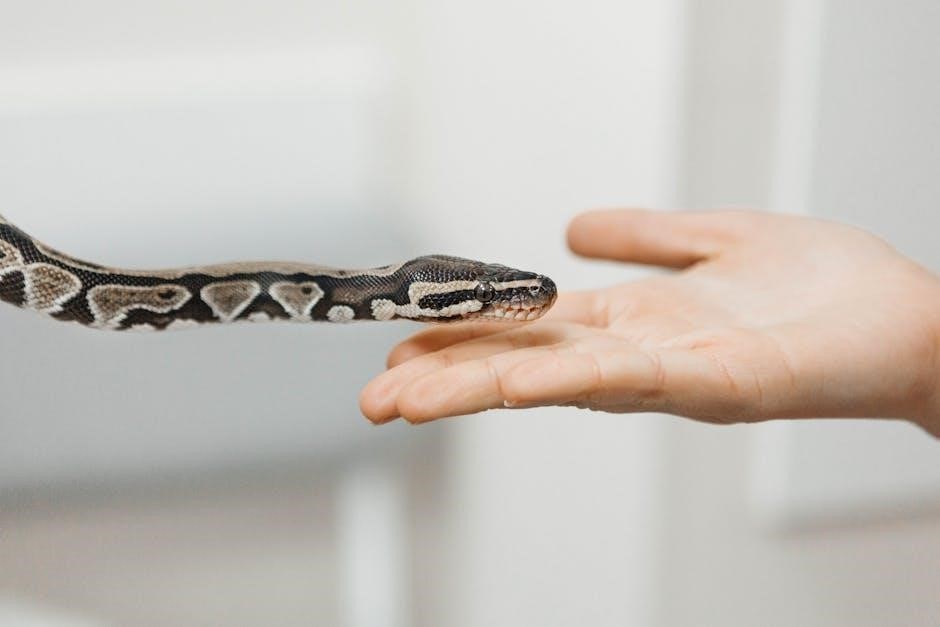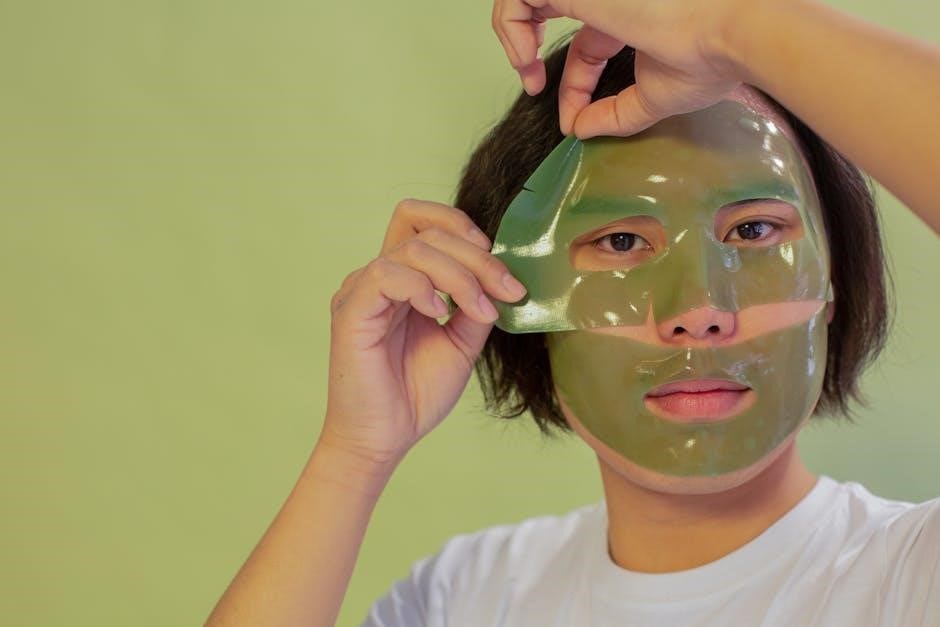Ball pythons are non-venomous snakes native to sub-Saharan Africa‚ known for their calm demeanor and attractive patterns. They are popular pets due to their manageable size‚ docile nature‚ and stunning color morphs. These snakes are named for their defensive behavior of curling into a ball when threatened. With proper care‚ they thrive in captivity‚ making them an excellent choice for both novice and experienced reptile enthusiasts.
Overview of Ball Python Characteristics
Ball pythons are non-venomous snakes native to sub-Saharan Africa‚ known for their striking appearance and calm temperament. They are medium-sized‚ with adults typically reaching 3-5 feet in length. These snakes are recognized for their attractive color patterns and diverse morphs‚ which have made them highly sought after by reptile enthusiasts. Ball pythons are constrictors‚ using their powerful bodies to immobilize prey. Their name comes from their unique defensive behavior of curling into a tight ball when threatened. They are generally docile‚ making them an excellent choice for both experienced and novice snake owners. Their average lifespan in captivity is 20-30 years‚ highlighting their long-term commitment as pets.
Why Ball Pythons Are Popular Pets
Ball pythons are among the most popular pet snakes due to their unique combination of traits. Their calm and docile nature makes them easy to handle‚ even for beginners. They come in a wide variety of stunning color morphs‚ offering aesthetic appeal to enthusiasts. Additionally‚ their relatively small size and simple care requirements make them a practical choice for many. Ball pythons are also quiet and non-aggressive‚ thriving in a well-maintained environment. Their long lifespan of 20-30 years ensures a lasting companion for dedicated owners. Overall‚ their gentle temperament‚ attractive appearance‚ and manageable care needs have solidified their place as a favorite among snake enthusiasts and breeders worldwide.

Habitat Setup
A 30-40 gallon tank is ideal for adult ball pythons. A secure lid helps maintain humidity. Use substrates like ReptiChip. Add decorations such as logs and plants;
Terrarium Size Guidelines for Ball Pythons
A 30-40 gallon terrarium is recommended for adult ball pythons‚ while juveniles thrive in smaller enclosures like a 20-gallon tank. The enclosure should allow the snake to fully stretch out‚ with a length of at least two-thirds of the snake’s body. A secure‚ screen-top enclosure is ideal for proper ventilation. Avoid placing juveniles in overly large spaces‚ as this can cause stress. The terrarium should provide ample space for movement and climbing‚ with a footprint that accommodates the snake’s natural behavior. Proper sizing ensures a comfortable environment‚ promoting health and reducing stress.
Lighting and Temperature Requirements
Ball pythons require a warm environment with a temperature gradient. The ambient temperature should range from 80-85°F (27-29°C) during the day‚ with a basking spot of 90°F (32°C). Nighttime temperatures can drop to 75-80°F (24-27°C). Use a high-quality heat source‚ such as a heat lamp or ceramic heat emitter‚ and avoid heat mats. Lighting should be on a 12-hour cycle to mimic natural daylight. UVB lighting is optional but can enhance overall health. Ensure proper ventilation to prevent overheating. A thermometer is essential for monitoring temperatures accurately. Avoid placing heat sources directly over the snake to prevent burns. Maintain a consistent temperature gradient to support digestion and overall well-being.
Humidity Levels for Optimal Health
Maintaining proper humidity is crucial for ball pythons‚ as it supports skin health‚ respiratory function‚ and shedding. Optimal humidity levels range between 50-60%. Increase humidity to 70-80% during shedding to facilitate a smooth process. Use a hygrometer to monitor levels accurately. Mist the enclosure lightly daily‚ especially in drier climates‚ to maintain humidity. Avoid excessive moisture‚ as it can lead to mold growth. Ensure airflow is adequate to prevent respiratory issues. Proper humidity balance is essential for preventing dehydration and promoting overall well-being. Mist more frequently for young ball pythons‚ as they are more sensitive to environmental conditions. Regular monitoring ensures a stable and healthy environment for your ball python.
Substrate Options and Recommendations
Choosing the right substrate for your ball python is essential for maintaining a clean and healthy environment. ReptiChip and sphagnum moss are highly recommended as they retain humidity well and reduce mold growth. Paper towels or indoor/outdoor carpeting are also excellent‚ low-maintenance options‚ especially for younger snakes. Avoid gravel‚ wood shavings‚ and sand‚ as they can cause respiratory issues or impaction. Substrate should be easy to clean and replaced completely every 2-3 months. Spot cleaning daily helps prevent bacterial buildup. Proper substrate choice supports humidity levels‚ reduces odors‚ and ensures your ball python’s comfort. Always prioritize substrates that promote a clean‚ dry‚ and stress-free habitat for your pet. Regular monitoring ensures optimal conditions for your ball python’s health and well-being.
Decorations for a Natural Environment

Creating a natural environment for your ball python enhances its well-being and mimics its wild habitat. Incorporate rocks‚ logs‚ and plants to provide hiding spots and climbing areas. Live plants like pothos or snake plants are excellent additions‚ as they purify the air and maintain humidity. Decorative elements such as water bowls‚ humidity hides‚ and substrate heaters contribute to a naturalistic setup. Avoid sharp or rough decorations that could harm your snake. A well-decorated enclosure reduces stress and encourages exploration‚ ensuring your ball python feels secure and comfortable in its home. Regularly inspect and clean all decorations to maintain a safe and healthy environment for your pet. Proper decoration also supports the snake’s natural behavior‚ promoting a balanced and thriving life in captivity.

Feeding Your Ball Python
Feeding your ball python involves offering pre-killed mice or rats‚ sized appropriately to the snake’s girth. Adults eat every 1-2 weeks‚ while juveniles need weekly meals.
What to Feed Your Ball Python
Ball pythons are carnivorous and primarily consume small mammals. Pre-killed mice and rats are the most common food sources. The prey size should match the snake’s mid-body girth to prevent digestive issues. For hatchlings and juveniles‚ hopper mice or small rats are ideal. As they grow‚ larger prey items are introduced. Avoid live prey to minimize the risk of injury to the snake. Pre-killed options are recommended for ease and safety. A varied diet ensures nutritional balance‚ though many owners stick to a consistent prey type. Fresh water must always be available to aid digestion and hydration.
Feeding Frequency by Age and Size
Feeding frequency for ball pythons varies based on age and size. Hatchlings typically require feeding every 7-10 days to support rapid growth. Juvenile ball pythons should be fed weekly‚ while sub-adults can be fed every 7-10 days. Adult ball pythons‚ depending on their size and activity level‚ are usually fed every 1-2 weeks. The feeding schedule should align with the snake’s energy needs and growth rate. Overfeeding can lead to obesity‚ so monitoring the snake’s body condition is crucial. Adjustments to the feeding frequency may be necessary to ensure optimal health and weight management.
Recognizing and Addressing Feeding Issues
Feeding issues in ball pythons can arise from stress‚ improper temperature‚ or health problems. Signs include refusal to eat‚ lethargy‚ or weight loss. Addressing these issues involves checking environmental conditions‚ ensuring proper humidity and temperature‚ and offering prey items of appropriate size. If a snake refuses food‚ try braining or scenting with a small mammal. Consult a veterinarian if issues persist. Preventative measures include maintaining a stress-free environment and monitoring feeding patterns to ensure optimal health.
Hydration Needs and Water Bowl Setup
Ball pythons require constant access to fresh‚ clean water for hydration‚ shedding‚ and digestive health. A shallow‚ heavy-bottomed water bowl large enough for the snake to soak in should be provided. Place the bowl in a cooler area of the enclosure to help maintain proper humidity levels. Change the water daily to prevent bacterial growth. Ensure the bowl is secure to avoid tipping. Humidity levels between 50-60% also aid hydration. Regular misting can supplement water needs but should not replace the water bowl. Always monitor the snake’s hydration status‚ as dehydration can lead to health issues. A clean‚ accessible water source is essential for maintaining optimal health in ball pythons.

Health and Maintenance
Regular cleaning‚ proper humidity‚ and a balanced diet are crucial for maintaining a ball python’s health. Monitor for signs of illness‚ such as lethargy or breathing issues‚ and consult a vet experienced in reptiles if concerns arise. Clean the enclosure weekly‚ and ensure good ventilation to prevent respiratory problems. A healthy ball python will have clear eyes‚ a robust body‚ and regular shedding. Maintain a clean environment to prevent parasites and infections‚ ensuring your snake stays thriving and active.

Signs of a Healthy Ball Python
A healthy ball python exhibits clear‚ bright eyes (unless shedding)‚ an active and alert demeanor‚ and a robust‚ well-rounded body. They should eat regularly‚ showing interest in food‚ and maintain a shiny‚ supple skin free of lesions or discoloration. Healthy snakes shed their skin in one piece‚ indicating proper humidity levels. Their feces should be solid and dark‚ with urates appearing white. A healthy ball python will curl up neatly when resting‚ displaying calm behavior. Avoid snakes with signs of illness‚ such as lethargy‚ labored breathing‚ or mites. Regular observation of these traits helps ensure your ball python thrives under proper care.
Common Health Issues in Ball Pythons
Ball pythons are generally hardy‚ but they can face certain health challenges. Respiratory infections are common‚ often due to poor ventilation or high humidity‚ and may cause wheezing or labored breathing. Parasites‚ such as mites or ticks‚ can infest your snake‚ leading to skin irritation and stress. Metabolic bone disease is another issue‚ typically resulting from inadequate UVB lighting or calcium deficiency. Impaction can occur if the snake ingests substrate while eating‚ causing digestive blockages. Additionally‚ inclusion body disease (IBD) is a viral infection that can lead to lethargy‚ refusal to eat‚ and neurological symptoms. Regular cleaning‚ proper habitat setup‚ and a balanced diet help prevent these issues‚ ensuring your ball python remains healthy.
Cleaning and Disinfecting the Habitat
Regular cleaning is essential for maintaining a healthy environment for your ball python. Remove feces and uneaten food daily to prevent bacterial growth. Every week‚ clean the entire habitat by replacing the substrate‚ scrubbing surfaces with a reptile-safe cleaner‚ and rinsing thoroughly. Disinfect all accessories‚ such as water and feeding bowls‚ with a 3% bleach solution or a commercial reptile disinfectant. After cleaning‚ allow the habitat to dry completely before reintroducing your snake. This routine helps prevent infections and keeps your ball python thriving. Always ensure the habitat is clean and free from harmful pathogens to promote optimal health.
Parasite Control and Prevention
Regular parasite checks are crucial for maintaining your ball python’s health. Internal parasites‚ such as mites or intestinal worms‚ can cause significant harm. Monitor your snake’s feces for unusual content and consult a veterinarian for fecal exams annually. Maintain a clean habitat by removing waste promptly and disinfecting regularly. Avoid feeding live prey‚ as it can introduce parasites. Instead‚ use pre-killed or frozen-thawed prey to minimize risks. Signs of infestation include lethargy‚ weight loss‚ or changes in appetite. If parasites are detected‚ treat promptly with prescribed medications. Prevention through proper hygiene and feeding practices ensures a healthy‚ thriving ball python.

Housing and Environment
A suitable enclosure for ball pythons should be secure‚ well-ventilated‚ and large enough to accommodate growth. A clean‚ escape-proof environment with proper airflow ensures their well-being and safety.
Recommended Cage Size for Adults vs. Juveniles
Adult ball pythons require a spacious enclosure‚ with a minimum size of 30-40 gallons‚ ensuring ample room to stretch and move comfortably. Juveniles‚ however‚ need smaller setups‚ typically a 10-20 gallon tank‚ to prevent stress from excessive space. A 30-gallon glass aquarium is often recommended for adults‚ while younger snakes thrive in more compact environments. The enclosure should allow the snake to fully extend its body‚ with a length at least one-third of the snake’s total length. Proper sizing ensures a stress-free environment‚ promoting healthy growth and well-being for both juvenile and adult ball pythons.
Importance of Ventilation in the Enclosure
Proper ventilation is essential for maintaining a healthy environment for ball pythons. It prevents the buildup of stagnant air‚ reduces moisture accumulation‚ and helps regulate temperature gradients. A well-ventilated enclosure reduces the risk of respiratory infections‚ a common health issue in snakes. Screen tops or ventilation holes are recommended to ensure airflow. Overly sealed enclosures can lead to high humidity levels‚ which can stress the snake and promote mold growth. Adequate ventilation also prevents the concentration of waste products‚ creating a cleaner and safer habitat. Ensuring good airflow is critical for the overall health and well-being of your ball python‚ supporting its respiratory system and preventing potential health complications.
Creating a Stress-Free Environment
Creating a stress-free environment for your ball python is crucial for its well-being. Ensure the enclosure provides adequate space‚ allowing the snake to move comfortably without feeling confined. A proper temperature gradient‚ humidity levels‚ and hiding places are essential to reduce anxiety. Avoid placing the enclosure in high-traffic areas or near loud noises‚ as this can disturb the snake. Introduce new items or changes gradually to prevent startling your ball python. Maintaining a clean and predictable environment helps minimize stress. Regular handling should be gentle and brief‚ especially for younger snakes‚ to build trust. A stress-free environment promotes a healthy‚ calm‚ and thriving ball python.

Handling and Temperament

Ball pythons are known for their docile and calm nature‚ making them ideal pets. They are non-venomous and typically tolerate handling well‚ though they may curl into a ball when stressed. Regular‚ gentle interaction helps build trust‚ creating a stress-free experience for both the snake and handler. Their temperament makes them a great choice for reptile enthusiasts of all experience levels.
How to Handle Your Ball Python Safely
To handle your ball python safely‚ approach it calmly and gently. Always support the snake’s body‚ ensuring it feels secure. Start with short sessions‚ gradually increasing time as trust builds. Avoid handling after feeding or when shedding‚ as this can cause stress. Support the snake’s mid-body and tail‚ allowing it to move freely without constriction. Never grab or restrain the snake‚ as this can lead to injury or stress. If the snake curls into a ball‚ respect its need for comfort and return it to its enclosure. Proper handling fosters a strong bond and ensures a stress-free experience for both you and your pet.

Understanding Ball Python Behavior
Ball pythons are known for their calm and docile nature‚ making them ideal pets. They are generally shy and prefer to hide or curl into a ball when threatened‚ which is how they got their name. In the wild‚ they are nocturnal hunters‚ but in captivity‚ they adapt to their owner’s schedule. Ball pythons are not aggressive and rarely bite‚ preferring to retreat to a secure location when stressed. They are excellent escape artists‚ so a secure enclosure is essential. Understanding their behavior helps in providing a stress-free environment‚ as they thrive when their needs for privacy and security are met. Recognizing signs of stress‚ such as pacing or refusing food‚ is crucial for maintaining their well-being.